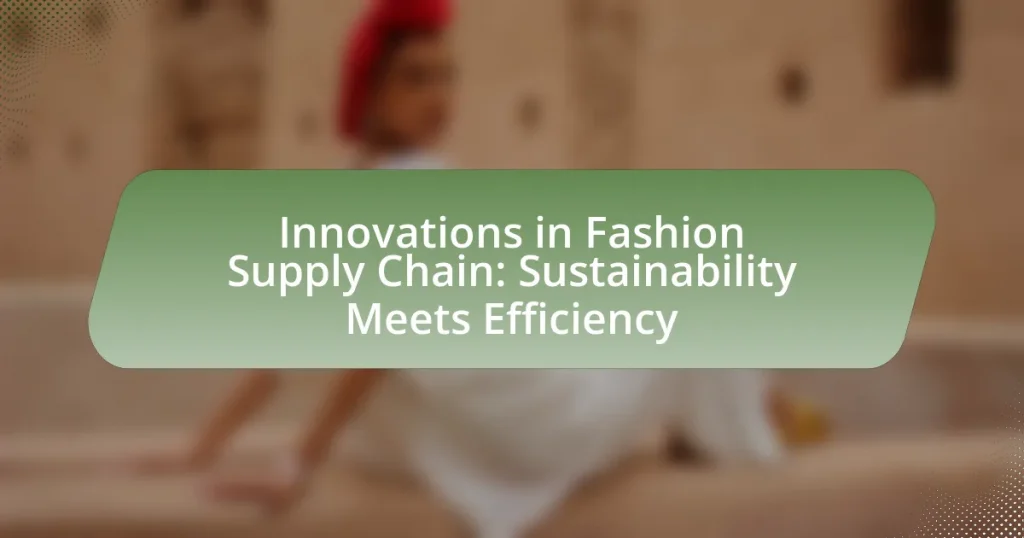The article focuses on innovations in the fashion supply chain, emphasizing the intersection of sustainability and efficiency. Key advancements include the adoption of digital technologies like blockchain and AI, the use of sustainable materials, and automation processes that enhance transparency, reduce waste, and optimize resource management. The discussion highlights how these innovations contribute to a more sustainable fashion industry by minimizing environmental impact and improving operational performance. Additionally, the article addresses the challenges of balancing sustainability with efficiency, the role of consumer demand, and best practices for integrating sustainable practices into supply chain processes.

What are the key innovations in the fashion supply chain?
Key innovations in the fashion supply chain include digital technologies, sustainable materials, and automation. Digital technologies, such as blockchain and AI, enhance transparency and efficiency by tracking products from production to retail, thereby reducing waste and improving inventory management. Sustainable materials, like organic cotton and recycled polyester, minimize environmental impact and cater to consumer demand for eco-friendly products. Automation, through robotics and AI-driven processes, streamlines manufacturing and logistics, leading to faster turnaround times and reduced labor costs. These innovations collectively contribute to a more efficient and sustainable fashion supply chain.
How do these innovations enhance sustainability?
Innovations in the fashion supply chain enhance sustainability by reducing waste, optimizing resource use, and promoting circular economy practices. For instance, technologies such as 3D printing and digital sampling minimize material waste by allowing for precise production and reducing the need for physical samples. Additionally, the implementation of blockchain technology improves transparency and traceability, enabling brands to ensure ethical sourcing and reduce environmental impact. According to a report by McKinsey & Company, sustainable practices in the fashion industry can lead to a 30% reduction in greenhouse gas emissions by 2030, demonstrating the significant potential of these innovations to foster a more sustainable future.
What technologies are driving sustainable practices in fashion supply chains?
Technologies driving sustainable practices in fashion supply chains include blockchain, artificial intelligence (AI), and the Internet of Things (IoT). Blockchain enhances transparency by providing a secure and immutable record of transactions, allowing brands to trace the origin of materials and ensure ethical sourcing. AI optimizes inventory management and demand forecasting, reducing waste by aligning production with actual consumer needs. IoT devices facilitate real-time monitoring of resource usage, enabling brands to minimize energy consumption and waste throughout the supply chain. These technologies collectively contribute to a more sustainable and efficient fashion industry.
How do sustainable materials impact the supply chain efficiency?
Sustainable materials enhance supply chain efficiency by reducing waste and lowering costs associated with raw material sourcing. The use of sustainable materials often leads to streamlined processes, as they are typically sourced from local suppliers, minimizing transportation costs and time. For instance, a study by the Ellen MacArthur Foundation found that adopting circular economy principles, which include the use of sustainable materials, can reduce supply chain costs by up to 30%. Additionally, sustainable materials often require less energy to produce, further increasing efficiency. This efficiency not only benefits the environment but also improves the overall profitability of companies within the fashion supply chain.
What role does technology play in improving supply chain efficiency?
Technology plays a crucial role in improving supply chain efficiency by enabling real-time data analysis and automation. Real-time data allows companies to monitor inventory levels, track shipments, and forecast demand accurately, leading to reduced lead times and minimized stockouts. For instance, the use of Internet of Things (IoT) devices can provide continuous updates on product conditions during transit, ensuring timely interventions when necessary. Additionally, automation technologies, such as robotic process automation (RPA), streamline repetitive tasks, reducing human error and increasing operational speed. According to a report by McKinsey, companies that leverage advanced analytics in their supply chains can achieve up to a 20% reduction in logistics costs and a 50% improvement in service levels. This demonstrates that technology not only enhances efficiency but also contributes to cost savings and improved customer satisfaction in the fashion supply chain.
How can data analytics optimize inventory management in fashion supply chains?
Data analytics can optimize inventory management in fashion supply chains by providing real-time insights into stock levels, demand forecasting, and supply chain efficiency. By analyzing historical sales data, fashion retailers can predict trends and adjust inventory accordingly, reducing overstock and stockouts. For instance, a study by McKinsey & Company found that companies using advanced analytics in their supply chains can reduce inventory costs by 10-20% while improving service levels. This data-driven approach enables better decision-making, enhances responsiveness to market changes, and ultimately leads to more sustainable inventory practices.
What are the benefits of automation in the fashion supply chain?
Automation in the fashion supply chain enhances efficiency, reduces costs, and improves accuracy. By automating processes such as inventory management, order fulfillment, and production scheduling, companies can minimize human error and streamline operations. For instance, a study by McKinsey & Company found that automation can reduce supply chain costs by up to 30% and increase order accuracy by 99%. Additionally, automation allows for real-time data analysis, enabling better decision-making and responsiveness to market trends. This leads to faster turnaround times and improved customer satisfaction, ultimately contributing to a more sustainable and efficient supply chain.

How does sustainability intersect with efficiency in fashion supply chains?
Sustainability intersects with efficiency in fashion supply chains by promoting resource optimization and waste reduction, which ultimately leads to cost savings and improved operational performance. For instance, implementing sustainable practices such as using eco-friendly materials and energy-efficient production processes can reduce the environmental impact while simultaneously lowering production costs. A study by the Ellen MacArthur Foundation highlights that circular economy practices in fashion can reduce costs by up to 30% through better resource management and waste minimization. This demonstrates that integrating sustainability into supply chain strategies not only benefits the environment but also enhances overall efficiency and profitability.
Why is it important to balance sustainability and efficiency?
Balancing sustainability and efficiency is crucial because it ensures that environmental goals are met without compromising operational performance. In the fashion supply chain, achieving this balance allows companies to reduce waste and resource consumption while maintaining profitability and competitiveness. For instance, a study by the Ellen MacArthur Foundation highlights that transitioning to a circular economy in fashion could generate $560 billion in economic benefits by minimizing waste and maximizing resource use. Thus, integrating sustainable practices with efficient processes not only supports ecological health but also drives economic growth.
What challenges arise when trying to achieve this balance?
Achieving a balance between sustainability and efficiency in the fashion supply chain presents several challenges. One significant challenge is the high cost associated with sustainable materials and processes, which can lead to increased production expenses. For instance, a study by McKinsey & Company indicates that sustainable materials can cost up to 30% more than conventional options, impacting profit margins. Additionally, integrating sustainable practices often requires substantial changes in existing supply chain operations, which can disrupt established workflows and lead to inefficiencies during the transition period. Furthermore, there is a lack of standardized metrics for measuring sustainability, making it difficult for companies to assess their progress and communicate their efforts effectively to consumers. These challenges collectively hinder the ability to achieve a seamless integration of sustainability and efficiency in the fashion supply chain.
How can companies measure the success of their sustainability efforts?
Companies can measure the success of their sustainability efforts through key performance indicators (KPIs) such as carbon footprint reduction, waste diversion rates, and resource efficiency metrics. For instance, a study by the Global Reporting Initiative indicates that organizations that track their greenhouse gas emissions can reduce them by an average of 20% over five years. Additionally, companies can assess their sustainability through stakeholder feedback, sustainability audits, and compliance with international standards like ISO 14001. These methods provide concrete data that reflect the effectiveness of sustainability initiatives, enabling companies to make informed decisions and adjustments to their strategies.
What are the best practices for integrating sustainability into supply chain processes?
The best practices for integrating sustainability into supply chain processes include adopting circular economy principles, utilizing sustainable materials, and implementing energy-efficient logistics. Circular economy principles encourage the reuse and recycling of materials, which can significantly reduce waste; for instance, companies like H&M have committed to using 100% recycled or sustainably sourced materials by 2030. Utilizing sustainable materials, such as organic cotton or recycled polyester, helps minimize environmental impact, as evidenced by brands like Patagonia, which sources recycled materials for its products. Implementing energy-efficient logistics, such as optimizing transportation routes and using electric vehicles, can lower carbon emissions; a study by the Carbon Trust found that optimizing logistics can reduce emissions by up to 30%. These practices collectively enhance sustainability in supply chains while promoting efficiency.
How can collaboration with suppliers enhance sustainability efforts?
Collaboration with suppliers enhances sustainability efforts by enabling the sharing of best practices, resources, and innovations that reduce environmental impact. When companies work closely with their suppliers, they can implement sustainable sourcing strategies, optimize resource use, and minimize waste throughout the supply chain. For instance, a study by the World Economic Forum found that collaborative initiatives in supply chains can lead to a 20-30% reduction in carbon emissions. This partnership fosters transparency and accountability, allowing for better tracking of sustainability metrics and compliance with environmental standards.
What role does consumer demand play in shaping sustainable supply chains?
Consumer demand significantly influences the development of sustainable supply chains by driving companies to adopt environmentally friendly practices. As consumers increasingly prioritize sustainability in their purchasing decisions, businesses respond by integrating eco-friendly materials, reducing waste, and enhancing transparency in their supply chains. For instance, a 2021 survey by McKinsey & Company found that 67% of consumers consider sustainability when making a purchase, prompting brands to innovate and align their operations with these values. This shift not only meets consumer expectations but also fosters competitive advantage in the market, reinforcing the importance of consumer demand in shaping sustainable practices within the fashion supply chain.

What are the future trends in fashion supply chain innovations?
Future trends in fashion supply chain innovations include increased adoption of digital technologies, such as blockchain for transparency, artificial intelligence for demand forecasting, and automation for efficiency. These technologies enable brands to track materials from source to consumer, optimize inventory levels, and reduce lead times. For instance, a McKinsey report highlights that companies leveraging AI can improve forecasting accuracy by up to 50%, leading to reduced waste and better alignment with consumer demand. Additionally, sustainability initiatives are becoming central, with brands focusing on circular supply chains and eco-friendly materials, reflecting a growing consumer preference for responsible fashion.
How will emerging technologies shape the future of fashion supply chains?
Emerging technologies will significantly shape the future of fashion supply chains by enhancing efficiency, transparency, and sustainability. Technologies such as blockchain will provide traceability, allowing brands and consumers to verify the origins of materials and labor practices, thereby fostering ethical consumption. Additionally, artificial intelligence and machine learning will optimize inventory management and demand forecasting, reducing waste and overproduction, which are critical issues in the fashion industry. For instance, a report by McKinsey & Company highlights that AI can improve forecasting accuracy by up to 50%, leading to more sustainable practices. Furthermore, the integration of Internet of Things (IoT) devices will enable real-time monitoring of supply chain processes, enhancing responsiveness and agility. These advancements collectively contribute to a more sustainable and efficient fashion supply chain, addressing both environmental concerns and consumer demands for transparency.
What impact will blockchain have on transparency in the supply chain?
Blockchain will significantly enhance transparency in the supply chain by providing a decentralized and immutable ledger that records every transaction. This technology allows all stakeholders, including manufacturers, suppliers, and consumers, to access real-time data regarding the origin, movement, and status of products. For instance, a study by Accenture found that 90% of supply chain executives believe blockchain will improve transparency and traceability, leading to increased trust among consumers and reduced fraud. By enabling detailed tracking of materials from source to end-user, blockchain fosters accountability and ethical practices within the supply chain.
How can artificial intelligence improve forecasting and demand planning?
Artificial intelligence can significantly enhance forecasting and demand planning by analyzing vast amounts of data to identify patterns and trends. AI algorithms utilize historical sales data, market trends, and consumer behavior to generate more accurate demand forecasts, reducing the risk of overstocking or stockouts. For instance, a study by McKinsey & Company found that companies using AI for demand forecasting can improve forecast accuracy by up to 30%. This increased accuracy leads to better inventory management, optimized supply chain operations, and ultimately, improved customer satisfaction.
What practical steps can companies take to implement these innovations?
Companies can implement innovations in the fashion supply chain by adopting sustainable materials, optimizing logistics, and leveraging technology. First, companies should source eco-friendly materials, such as organic cotton or recycled polyester, to reduce environmental impact. For instance, brands like Patagonia have successfully integrated recycled materials into their products, demonstrating a commitment to sustainability.
Next, optimizing logistics through data analytics can enhance efficiency. Companies can utilize software to analyze supply chain data, reducing transportation costs and minimizing carbon footprints. A study by McKinsey & Company found that companies that optimize their logistics can achieve up to a 15% reduction in costs.
Finally, leveraging technology such as blockchain can improve transparency and traceability in the supply chain. By implementing blockchain, companies can track the origin of materials and ensure ethical sourcing, as seen in initiatives by brands like Everledger. These practical steps collectively contribute to a more sustainable and efficient fashion supply chain.
What resources are available for companies looking to adopt sustainable practices?
Companies looking to adopt sustainable practices can access a variety of resources, including sustainability consulting firms, industry-specific guidelines, and government incentives. Sustainability consulting firms provide expertise in implementing eco-friendly practices, while organizations like the Sustainable Apparel Coalition offer tools such as the Higg Index to measure environmental impact. Additionally, government programs often provide financial incentives or grants to support sustainable initiatives, which can be crucial for companies transitioning to greener operations. These resources collectively facilitate the integration of sustainability into business models, enhancing both environmental responsibility and operational efficiency.
How can businesses effectively communicate their sustainability efforts to consumers?
Businesses can effectively communicate their sustainability efforts to consumers by utilizing transparent messaging and engaging storytelling. Transparency involves providing clear, accessible information about sustainable practices, such as sourcing materials responsibly and reducing carbon footprints. For instance, a study by Nielsen found that 66% of global consumers are willing to pay more for sustainable brands, indicating that clear communication can enhance consumer trust and loyalty. Engaging storytelling can further connect consumers emotionally to sustainability initiatives, showcasing real-life impacts and benefits. By combining these strategies, businesses can foster a deeper understanding and appreciation of their sustainability efforts among consumers.
What are the common pitfalls to avoid in fashion supply chain innovations?
Common pitfalls to avoid in fashion supply chain innovations include lack of collaboration, insufficient data integration, and neglecting sustainability. Lack of collaboration among stakeholders can lead to misaligned goals and inefficiencies, as evidenced by studies showing that companies with strong partnerships achieve 20% higher performance. Insufficient data integration hampers decision-making and responsiveness, with research indicating that 70% of supply chain professionals cite data silos as a major barrier to innovation. Finally, neglecting sustainability can result in reputational damage and regulatory challenges, as consumers increasingly demand environmentally responsible practices, with 66% willing to pay more for sustainable brands.




